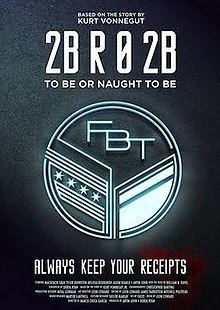Directed by Marco Checa Garcia Screenplay by Derek Ryan Cinematography Christopher Banting | Produced by Artin JohnDerek Ryan Music by Leon Coward Running time 18 minutes | |
 | ||
Based on 2 B R 0 2 Bby Kurt Vonnegut | ||
2br02b to be or naught to be 2016 trailer
2BR02B: To Be or Naught to Be is a 2016 Canadian short science fiction film directed by Marco Checa Garcia based on the short story "2 B R 0 2 B" by Kurt Vonnegut. The film was an international collaboration over nearly three years, with additional crew in Sydney, London, Mexico, and the Netherlands. The film features a cameo voice role by veteran actor and The X-Files star William B. Davis. The film's sound was designed by BAFTA-winner Martin Cantwell.
Contents
- 2br02b to be or naught to be 2016 trailer
- 2br02b to be or naught to be
- Plot
- Cast
- Production
- Music
- Release
- Reception
- References
2br02b to be or naught to be
Plot
In the year 2204, the Earth has become a dystopian wasteland. In order to maintain strict population levels, any newborn is only permitted to live if another person's life is traded in and a receipt issued. Edward K. Wehling, Jr. sits in Chicago Lying-In Hospital waiting for the birth of his triplets, except he has no receipts to collect them.
Cast
Production
An IndieGoGo crowdfunding campaign was announced in a press release on 20 November 2013. Shortly after, it was announced that actor Paul Giamatti was attached to the project as the character Dr. Hitz. Actor Mackenzie Gray took the role of Dr. Hitz after Giamatti left due to scheduling conflicts.
The film's visual design was prepared by artists working from Vancouver, Sydney, and the Netherlands. Filming took place over three days at the Waterfall Building in Canada. Visual effects were mostly done by Facet School of VFX, Mexico. The film was edited in Vancouver, but its picture lock was undone and post-production was moved to Sydney for editing, additional visual effects and music. Sound designer Martin Cantwell joined the project, working from London.
Music
The film's soundtrack makes extensive use of Schubert's Ave Maria in a version recorded especially for the film by Australian soprano and conductor Dr. Imogen Coward.
Release
The film premiered at the Sci-Fi-London festival on 29 April 2016, and later in Los Angeles at the Oscar-qualifying HollyShorts Film Festival. Shortly after, the film was selected for the Oscar-qualifying LA Shorts Fest.
An official trailer was released on 1 November 2016.
Reception
2BR02B: To Be or Naught to Be received positive reviews from critics, festival organizers and festival audiences. Daniel Abella, director of the New York Science Fiction Festival, called it one of the six must-see films of the festival and Outer Place critic Chris Mahon described it as "well-executed and beautifully shot." WILDsound Fest's official full-length review of the film by Kierston Drier described it as "one of those rare gems of short cinema that will set your philosophical mind in motion... There is a level of polish and richness that any lover of science fiction and literature will appreciate and admire." John Vaughan, director of The Golden Blasters (The National Irish Science Fiction Film Festival) described the film as "An unconventional short film... it captures the sense of unease that would come if you glimpsed this particular future." Dumbbells & Dragons critic Rachel Bohlen rated the film as her third favourite from the HollyShorts Film Festival (Los Angeles), describing the film as a "terrifying view of our future" and that the adaptation "adheres almost completely to the short story, and I must warn you – there’s no happy ending here. It’s bleak but thought-provoking."
Both the film's art direction and soundtrack have also received critical praise. CEO of WILDsound Fest, Matthew Toffolo and the festival's audience praised Leon Coward's interpretation of The Happy Garden of Life mural into a complex, story-rich work of art, concluding that "from a cinematic point of view... they did nail it." In an essay/interview published in The Schubertian (Journal of the Schubert Institute UK), Anna Black described the soundtrack's use of Schubert's Ave Maria as "a lasting and haunting shred of beauty and humanity in a future where it has otherwise been abandoned."
